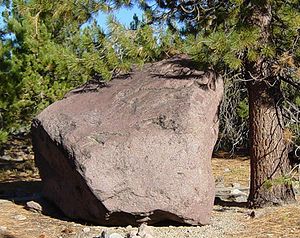Lassen Peak
| Lassen Peak | |
|---|---|
 |
Lassen Peak, in Shasta County, California USA, is the largest single lava dome volcano also known as a plug dome in the world and is the southernmost volcano in the Cascade Range. A plug dome volcano is a volcano that is composed of alternate layers of lava and volcanic ash. It is also known as Mount Lassen. It was created on the destroyed northeastern flank of now gone Mount Tehama, a stratovolcano that was at least a thousand feet (300 m) higher than Lassen. Lassen is located in north-central California in the Shasta Cascade region and is the centerpiece of Lassen Volcanic National Park.
Lassen Peak has the distinction of being the only other volcano in the Cascades besides Mount St. Helens to have erupted during the 20th Century. Eruptive activity began in 1914 and ended in 1917.
Unlike most lava domes, Lassen is topped by craters. In fact a series of these craters exist around Lassen's summit, although two of these are now covered by solidified lava and sulfur deposits.
Lassen peak has one of the highest snowfall amounts for California. With an average annual snowfall of 660 inches (16.76 m) , and some years receiving over 1000 inches (25.4 m) of snow at its base of 8,250 feet (2,514 m) at Lake Helen. Lassen Peak gets more precipitation (rain, hail, melted snow) anywhere in the Cascades south of the Three Sisters Volcanoes ([1] ski mountaineer).
Geology
See also Geology of the Lassen area for more information.
Roughly 27,000 years ago, Lassen Peak started to form as a dacite lava dome quickly pushed its way through Tehama's destroyed north-eastern flank. As the lava dome pushed its way up, it shattered overlaying rock, which formed a blanket of talus around the emerging volcano. Lassen rose and reached its present height in a relatively short time, probably in as little as a few years. Lassen Peak has also been partially eroded by Ice Age glaciers, at least one of which extended as much as 7 miles (11 km) from the volcano itself.
History
Before the arrival of white settlers, the areas surrounding Lassen Peak, especially in the east and south, were the traditional home of the (Northeastern) Maidu.
Lassen Peak was named in honor of Danish blacksmith Peter Lassen, who guided immigrants past the peak to Sacramento Valley in the 1830s. Lassen's trail, however, never found general long-term use because it was considered unsafe. Nobles Emigrant Trail, named after William Nobles, which linked Applegate Trail in Nevada to Northern Sacramento Valley, replaced it.
In 1864 Helen Tanner Brodt became the first woman to reach the summit of Lassen Peak. A tarn (lake in a cirque basin) on Lassen was named Lake Helen in her honor.
Starting in 1914 and ending in 1921 Lassen came alive with a series of phreatic eruptions (steam explosions), dacite lava flows, and lahars (volcanic mud flows). There were 200 to 400 volcanic eruptions during this period of activity, but nobody was reported killed or seriously injured.
On May 15, 1915 a dacite flow oozed 1000 feet (300 m) down the western side of Lassen before it hardened. Observers 20 miles (30 km) away said it looked like the peak was boiling over for two hours. Heat from the lava melted much of the snowpack on the mountain and destroyed the deep crater lake atop the peak, which created a lahar that filled Lost Creek and then Hat Creek.
Then at 4:30 p.m. on May 22, 1915 a violent explosion (referred to as "the Great Explosion") ejected a very large mushroom-shaped cloud of ash thousands of feet skyward. A pyroclastic flow shattered and burned trees on the northwest slope and reactivated the lahar there. Together these events created the Devastated Area which is still sparsely populated by trees due to the low nutrient and high porosity of the soil there.
In April, May and June 1917 a series of dramatic steam and ash explosions emanated from the summit area and blasted out a fourth summit crater there (on the northwest corner).
Since then, the USGS in cooperation with the United States Park Service have been monitoring Lassen and other volcanic and geothermal areas in the park.

See also
- High Cascades
- Mount Baker
- Mount Rainier
- Mount St. Helens
- Mount Adams
- Glacier Peak
- Mount Hood
- Mount Jefferson
- Three Sisters
- Mount Shasta
- Crater Lake
Reference
- Geology of National Parks: Fifth Edition, Ann G. Harris, Esther Tuttle, Sherwood D., Tuttle (Iowa, Kendall/Hunt Publishing; 1997) ISBN 0-7872-5353-7

